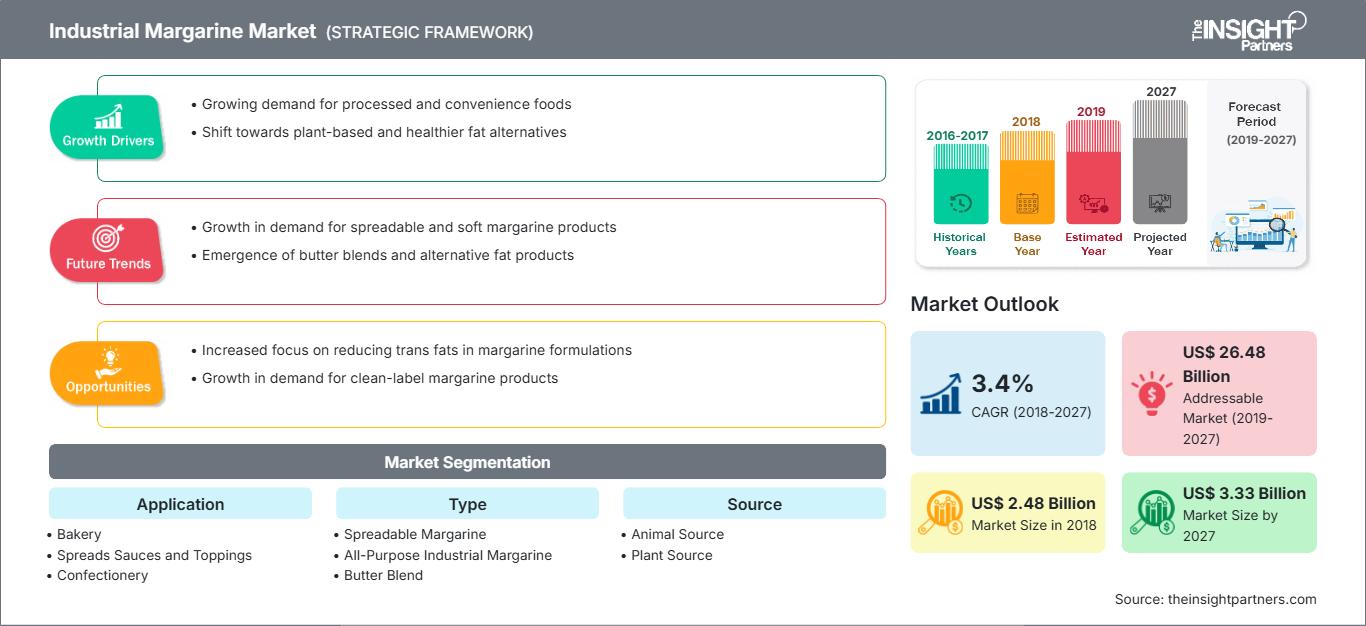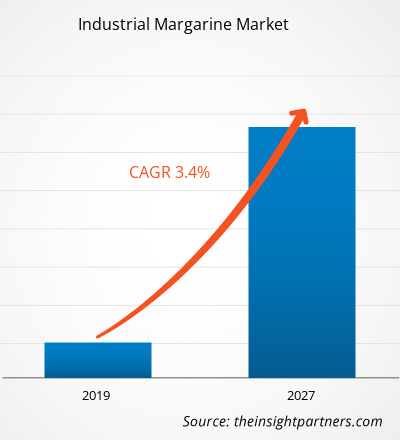[Rapporto di ricerca]Il mercato della margarina industriale è stato valutato a 2.480,0 milioni di dollari nel 2018 e si prevede che raggiungerà i 3.330,4 milioni di dollari entro il 2027; si prevede una crescita a un CAGR del 3,4% dal 2019 al 2027.
La margarina industriale è un prodotto lattiero-caseario utilizzato come sostituto del burro. Sebbene sia la margarina industriale che il burro vengano utilizzati per migliorare il sapore di una varietà di piatti, presentano caratteristiche distinte. Acqua, proteine e grasso butirrico costituiscono il burro, mentre grassi animali e/o oli vegetali lavorati costituiscono la margarina industriale.
Si prevede che il mercato della margarina industriale in Nord America crescerà al CAGR più elevato durante il periodo di previsione. La crescita del mercato in questa regione è principalmente attribuita alla crescente prevalenza di malattie come diabete, ipertensione e stitichezza, poiché i consumatori stanno diventando più attenti alla salute. Per questo motivo, i produttori alimentari negli Stati Uniti si stanno concentrando sulla produzione di margarine prive di grassi trans. La crescente domanda di margarina industriale è alimentata dal numero di nuovi lanci di margarine modificate da parte dei produttori di margarina, come creme spalmabili a basso contenuto di grassi o senza grassi e margarina fortificata con latte arricchito con vitamina D. La crescente domanda di margarina industriale in Nord America ha spinto i produttori a consolidare la propria presenza nella regione, il che ha ulteriormente alimentato la crescita del mercato della margarina industriale in Europa.
Personalizza questo rapporto in base alle tue esigenze
Potrai personalizzare gratuitamente qualsiasi rapporto, comprese parti di questo rapporto, o analisi a livello di paese, pacchetto dati Excel, oltre a usufruire di grandi offerte e sconti per start-up e università
Mercato della margarina industriale: Approfondimenti strategici

- Ottieni le principali tendenze chiave del mercato di questo rapporto.Questo campione GRATUITO includerà l'analisi dei dati, che vanno dalle tendenze di mercato alle stime e alle previsioni.
Impatto della pandemia di COVID-19 sul mercato della margarina industriale
Potrai personalizzare gratuitamente qualsiasi rapporto, comprese parti di questo rapporto, o analisi a livello di paese, pacchetto dati Excel, oltre a usufruire di grandi offerte e sconti per start-up e università
Mercato della margarina industriale: Approfondimenti strategici

- Ottieni le principali tendenze chiave del mercato di questo rapporto.Questo campione GRATUITO includerà l'analisi dei dati, che vanno dalle tendenze di mercato alle stime e alle previsioni.
L'epidemia di COVID-19 ha avuto un impatto negativo sulle economie e sui settori industriali di diversi Paesi a causa di lockdown, divieti di viaggio e chiusure aziendali. Alimenti e bevande sono tra i settori più significativi che hanno subito gravi interruzioni, come restrizioni alla catena di approvvigionamento e chiusura degli impianti di produzione. Gli effetti globali della malattia da coronavirus 2019 (COVID-19) si stanno già facendo sentire e la domanda di margarina in blocchi nel 2020 ne risentirà in modo significativo. Il COVID-19 ha influenzato il comportamento e la domanda dei consumatori, le abitudini di acquisto, il reindirizzamento della catena di approvvigionamento, le dinamiche di mercato e l'interferenza governativa. Pertanto, questi fattori stanno frenando la crescita del mercato della margarina industriale nel settore alimentare e delle bevande.
Approfondimenti di mercato: si prevede che la crescente domanda di alimenti ipocalorici alimenterà la crescita del mercato della margarina industriale
Il mercato della margarina industriale è in crescita grazie alla crescente domanda di alimenti e bevande a basso contenuto di grassi, derivante dall'evoluzione degli stili di vita e dalla crescente consapevolezza della salute. I giovani stanno diventando più consapevoli dei benefici per la salute derivanti da una dieta equilibrata, come la prevenzione dell'obesità e del diabete. La crescita del mercato dovrebbe essere favorita da un aumento del numero di alimenti ipocalorici disponibili nei supermercati, nonché da importanti sforzi di ricerca e sviluppo intrapresi dai produttori per ampliare la loro gamma di prodotti e vendere prodotti migliori a prezzi bassi. Vandemoortele, Unilever Plc, Richardson International Limited e Conagra Brands, Inc. sono tra i principali produttori di margarina industriale che vendono margarina industriale a basso contenuto calorico per attrarre le giovani generazioni attente alla salute.
Approfondimenti sulla tipologia
In base alla tipologia, il mercato della margarina industriale si divide in margarina spalmabile, margarina industriale multiuso e miscela di burro. Il segmento della margarina industriale spalmabile ha rappresentato una quota di mercato maggiore nel 2018. Rispetto al burro, la margarina industriale ha una migliore spalmabilità a temperatura ambiente. Grazie alla sua superiore spalmabilità rispetto al burro, la margarina è diventata una crema spalmabile più popolare e meno costosa. La margarina industriale è ancora una crema spalmabile comune per toast e pane. È comunemente usata come sostituto del burro più costoso grazie alla sua consistenza liscia e cremosa. Le margarine spalmabili sono spesso a basso contenuto di colesterolo e grassi trans, il che le rende un'alternativa equilibrata. Il basso contenuto di colesterolo LDL nella margarina industriale probabilmente guiderà il mercato, poiché viene consumata sempre più da consumatori attenti al colesterolo.
Si prevede quindi che tutti questi fattori contribuiranno a far crescere la domanda di margarina industriale durante il periodo di previsione.
Approfondimenti sulle applicazioni
In base all'applicazione, il mercato della margarina industriale è segmentato in prodotti da forno, creme spalmabili, salse e guarnizioni, dolciumi, cibi pronti e altri. Il segmento dei prodotti da forno ha rappresentato la quota di mercato maggiore nel 2018. La margarina per croissant, la margarina per pasta sfoglia, la margarina per crema al burro, la margarina per torte e la margarina per pasta sfoglia sono i tipi di margarina industriale più popolari utilizzati nell'industria della panificazione. La margarina viene utilizzata per rendere tenero l'impasto di grano in una varietà di prodotti da forno. I fornai preferiscono la margarina per la sua consistenza morbida, che facilita la preparazione di glasse alla crema al burro o di zucchero a velo per pan di Spagna. I dolci danesi sono preparati con margarina arrotolata. La margarina in panetti, nota anche come margarina a blocchi o margarina grezza, ha una consistenza simile al burro e viene quindi utilizzata come sostituto del burro in pasticceria e in cucina. Durante il periodo di previsione, si prevede che l'aumento del consumo di margarina industriale da parte dei prodotti da forno alimenterà la domanda di questo prodotto.
Alcuni attori che operano nel mercato della margarina industriale sono Associated British Foods, Bunge Limited, Conagra Foodservice, Inc., EFKO Group, Fuji Oil Europe, NMGK Group, Puratos, Richardson International Limited, Vandemoortele e Wilmar International Limited, tra molti altri. Le aziende chiave implementano fusioni e acquisizioni, nonché strategie di ricerca e sviluppo per espandere la base clienti e acquisire quote significative nel mercato globale, il che consente loro anche di mantenere il proprio marchio a livello globale.
Approfondimenti regionali sul mercato della margarina industriale
Le tendenze regionali e i fattori che influenzano il mercato della margarina industriale durante il periodo di previsione sono stati ampiamente spiegati dagli analisti di The Insight Partners. Questa sezione analizza anche i segmenti e la geografia del mercato della margarina industriale in Nord America, Europa, Asia-Pacifico, Medio Oriente e Africa, America meridionale e centrale.
Ambito del rapporto sul mercato della margarina industriale
| Attributo del rapporto | Dettagli |
|---|---|
| Dimensioni del mercato in 2018 | US$ 2.48 Billion |
| Dimensioni del mercato per 2027 | US$ 3.33 Billion |
| CAGR globale (2018 - 2027) | 3.4% |
| Dati storici | 2016-2017 |
| Periodo di previsione | 2019-2027 |
| Segmenti coperti |
By Applicazione
|
| Regioni e paesi coperti | Nord America
|
| Leader di mercato e profili aziendali chiave |
|
Densità degli operatori del mercato della margarina industriale: comprendere il suo impatto sulle dinamiche aziendali
Il mercato della margarina industriale è in rapida crescita, trainato dalla crescente domanda da parte degli utenti finali, dovuta a fattori quali l'evoluzione delle preferenze dei consumatori, i progressi tecnologici e una maggiore consapevolezza dei benefici del prodotto. Con l'aumento della domanda, le aziende stanno ampliando la propria offerta, innovando per soddisfare le esigenze dei consumatori e sfruttando le tendenze emergenti, alimentando ulteriormente la crescita del mercato.

- Ottieni il Mercato della margarina industriale Panoramica dei principali attori chiave
- Tendenze progressive del settore nel mercato della margarina industriale per aiutare gli operatori a sviluppare strategie efficaci a lungo termine
- Strategie di crescita aziendale adottate dai mercati sviluppati e in via di sviluppo
- Analisi quantitativa del mercato della margarina industriale dal 2019 al 2027
- Stima della domanda globale di margarina industriale
- Analisi PEST per illustrare l'efficacia di acquirenti e fornitori che operano nel settore
- Sviluppi recenti per comprendere lo scenario competitivo del mercato
- Tendenze e prospettive di mercato, nonché fattori che guidano e frenano la crescita del mercato della margarina industriale
- Assistenza nel processo decisionale evidenziando le strategie di mercato che sostengono l'interesse commerciale, portando alla crescita del mercato
- Dimensioni del mercato della margarina industriale in vari nodi
- Panoramica dettagliata e segmentazione del mercato, nonché dinamiche del settore della margarina industriale
- Dimensioni del mercato della margarina industriale in varie regioni con promettenti opportunità di crescita
Mercato della margarina industriale - per applicazione
- Panetteria
- Spalmabili, salse e condimenti
- Dolciumi
- Cibo pronto
- Altro
Mercato della margarina industriale - per tipo
- Margarina spalmabile
- Margarina industriale multiuso
- Miscela di burro
Mercato della margarina industriale - per fonte
- Fonte animale
- Fonte vegetale
Mercato della margarina industriale - per tipo ... per modulo
- Margarina industriale dura
- Margarina industriale morbida
Profili aziendali
- Bunge Limited
- Associated British Foods plc.
- Conagra Brands, Inc.
- EFKO Group
- Fuji Oil Europe
- NMGK Group
- Puratos
- Richardson International Limited
- Vandemoortele
- Wilmar International Ltd.
- Analisi storica (2 anni), anno base, previsione (7 anni) con CAGR
- Analisi PEST e SWOT
- Valore/volume delle dimensioni del mercato - Globale, Regionale, Nazionale
- Industria e panorama competitivo
- Set di dati Excel
Report recenti
Testimonianze
Motivo dell'acquisto
- Processo decisionale informato
- Comprensione delle dinamiche di mercato
- Analisi competitiva
- Analisi dei clienti
- Previsioni di mercato
- Mitigazione del rischio
- Pianificazione strategica
- Giustificazione degli investimenti
- Identificazione dei mercati emergenti
- Miglioramento delle strategie di marketing
- Aumento dell'efficienza operativa
- Allineamento alle tendenze normative




















 Ottieni un campione gratuito per - Mercato della margarina industriale
Ottieni un campione gratuito per - Mercato della margarina industriale